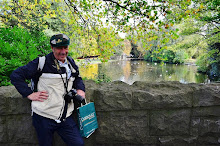WALKING LJUBLJANA
So next day we ventured out, Lorraine intent on shopping in
earnest so that, in addition to the four pairs of shoes that she’d packed (all
necessary of course) she now added another two which hopefully should do her
until our luggage eventually arrived.
We wandered aimlessly after that, drifting south towards a
park that appeared on our street guide and came upon an impressive looking
opera house with semi-circular classical front.
Beyond that was a park whose featured statue was that of Valvasor, a 17thC
natural historian and fellow of the Royal Society in London, whose pioneering
work on karst formations and 15 volumes (3532 pages – 528 illustrations) called
the Glory of the Duchy of Carnolia is considered the main go-to book for old
Slovenian history, made him something of a legend. His life was epic, he’s considered Slovenia’s
Renaissance man. After travelling for 14
years and doing two stints fighting wars for Austria after his parents died, he
tired of formal education, set up a printing enterprise and published so much
it ultimately sent him broke, requiring his castle to be sold with its 10,000
books.
It led us to the next building, the local museum where,
fortunately, there was an exhibition of Chinese gold artefacts. To put it
mildly, the quality of the historical items was absolutely superb. Via a project she’s doing, Lorraine had been
involved in gold work and so we both got immense pleasure out of noting the
fine detail in these items. There’s
heaps of other stuff to see but we only touched a fraction on it, mainly
tombstones dating from the first century to the Middle Ages but the outstanding
piece was a bronze statue of some Roman in classic senatorial pose in a toga. Once there were many bronze statues, they
outnumbered marble but, of course, you can’t melt marble down when times are
tough and so it is that there are hardly any Roman bronzes left these days.
We moved out, down another street and saw a fine three story
edifice topped by cupolas across the way, just as we fell into a conversation
with a lady in uniform. No sooner had we
started conversing that she was shouted at and told to desist by someone inside
the perimeter. Apparently it’s the
American Embassy and we all know what their security is like.
We walked away, down another block and there was another,
less protected and more promising structure.
Its five domes and varied exterior beckoned us onwards into the Serbian
Orthodox Church where we gazed in wonder at the frescoed interior of this 1936
icon. It seems every available bit of
wall and ceiling was painted and, from the roof hung an extraordinary
chandelier, about the largest I’ve ever seen.
People came and went, some lit candles, others kissed
something covered in glass, we mainly ogled because we’ve not had a great deal
of experience with Orthodox Churches, certainly not of this quality. A kindly multi-lingual gent tended the gift
shop within and he garnered some of our money on a few touristy items as we
were leaving.
Jakov Bdar - Adam and Eve fleeing the Garden of Eden
Back out in the sunshine we made for the Triple Bridges, the
centre point of Ljubljana, where eye-catching sculptures of distorted figures
by noted sculptor Jakov Brdar seemed to pop up everywhere but, the ultimate
meeting place is adorned with a more recognisable figure, that of Slovenia’s
most famous poet France Preseren who stands facing the window of his much loved Julija
Primic while beneath him are bas relief scenes from his poetry. Above him is a
seated muse holding an olive branch.
We wander past a piano accordion busker who takes umbrage at
our taking pictures without offering money first and head further on to Zmajski
most, a.k.a. the Dragon Bridge
where the most photographed sculptures of all are four dragons. Here the “selfies” are queueing to get a snap
of themselves in front of someone’s interpretation of a dragon. We are amused when a little girl on her knees
leans down and kisses the glass walkway.
If you’re an Aussie
though, you’ll be heading over to the funicular that takes you to the castle
where, right near the base is a bronze of, wait for it, a kangaroo! Its pouch doubles as a fountain which only
serves to add to the allure. Still can’t
believe it.
We took time out to ride the rails to the top and, upon
alighting, found we’d stumbled onto a wedding.
What was more karma was that the groom was an Aussie. He was marrying a pom and I was eyeing off
the food stuffs but decided not to do a dash and grab.
The most interesting part of the castle is a small
historical museum but I have to rush through because Lorraine is getting
tired. The views are good but, as a
castle, we’ve definitely seen better.
It’s time to descend the funicular and head for our digs,
past the couple in lederhosen and a braless girl in a singlet with what seem
like small horns wrapped in hair attached to her scalp. It’s all too much, time to wait for another
day.
%20Valvasor.JPG)
.JPG)
.JPG)
.JPG)
.JPG)
.JPG)
.JPG)
.JPG)
.JPG)
%20-%20France%20Preseren%20-%20poet.JPG)
%20-%20Jakov%20Brdar%20-%20Adam%20and%20Eve%20fleeing%20the%20garden%20of%20Eden.JPG)
-1.jpg)
.JPG)
.JPG)
.JPG)
.JPG)
.JPG)
.JPG)
.JPG)
.JPG)
.JPG)
.JPG)
.JPG)
.JPG)
.JPG)
.JPG)
.JPG)
.JPG)
.JPG)
-1.jpg)
.JPG)
.JPG)
.JPG)
.JPG)
-1.jpg)
.JPG)
.JPG)

